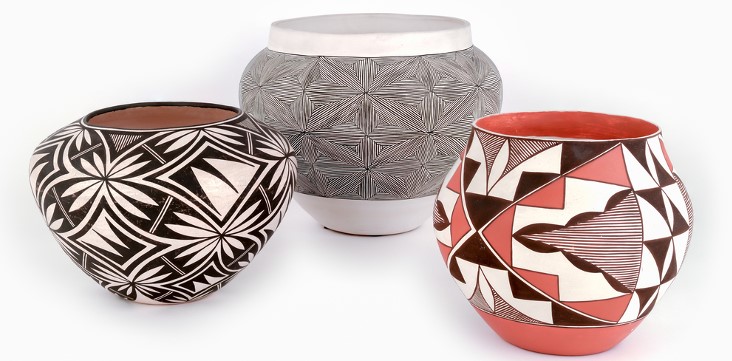MUSEUMS MUST RETURN NATIVE ARTIFACTS: IT’S THE LAW!

Young,Woman,In,Costume,Of,American,Indian
By Logan Jaffe and Mary Hudetz
Series: The Repatriation Project: The Delayed Return of Native Remains
America’s institutions maintain control of more than a hundred thousand remains of Native Americans as well as sacred items. A federal law, the Native American Graves Protection and Repatriation Act, was meant to help return them, but decades after its 1990 passage, many tribes are still waiting.

The American Museum of Natural History, one of the country’s largest museums whose prestige was built in part on excavating Native American gravesites, is shuttering some of its longtime exhibits that display cultural materials that could be subject to return to tribal nations.
The move comes as the New York City museum and many others, including the Field Museum of Natural History in Chicago, consult with tribes and evaluate their compliance with new federal regulations intended to speed up the process of returning ancestral remains and sacred items under the Native American Graves Protection and Repatriation Act. ProPublica published a series of articles last year, called “The Repatriation Project,” about the failures of museums to comply with the law in the past three decades.
Sean Decatur, president of the American Museum of Natural History, told staff in a letter on Friday that the “Eastern Woodlands and Great Plains Halls” will be closed to the public starting Saturday. The letter, provided to ProPublica, was first reported by The New York Times. Both exhibit halls, which contain numerous items from tribes in Montana, the Dakotas, Wisconsin and other states, are “severely outdated,” Decatur said.
“While the actions we are taking this week may seem sudden, they reflect a growing urgency among all museums to change their relationships to, and representation of, Indigenous cultures,” Decatur wrote to staff. “The Halls we are closing are vestiges of an era when museums such as ours did not respect the values, perspectives, and indeed shared humanity of Indigenous peoples.”
This month, the Field Museum also announced it would cover several displays of tribal items, as reported by Native News Online. In a statement, the Field Museum said it is “committed not only to compliance with NAGPRA but to consultation and collaboration with affiliated communities whose heritage is represented in our galleries.”
ProPublica’s reporting based on federal data shows at least 160 tribes may be eligible to claim ancestral remains, funerary items and other sacred objects from the American Museum of Natural History; for the Field Museum, at least 134 may make repatriation claims.
The new federal regulations, which went into effect this month, prohibit the display of items subject to NAGPRA without tribal consent and ban all research done without tribal consent. In addition, the regulations closed a loophole that had allowed museums such as the American Museum of Natural History to keep ancestral remains and burial items by claiming that they are “culturally unidentifiable” — meaning in their view they could not be connected to present-day Indigenous communities based on available evidence — and therefore could not readily be returned to tribes.
Museums will be required to determine, in consultation with tribes, which community can rightfully claim human remains or items in their collections. If a museum finds that it still cannot make a determination, it would have to say why in a notice filed in the Federal Register, Melanie O’Brien, manager of the National NAGPRA Program, an office within the Interior Department’s National Park Service, previously told ProPublica.
Three decades after legislation pushed for the return of Native American remains to Indigenous communities, most of the nation’s top museums and universities still have the remains of thousands of people in their collections.

Although the American Museum of Natural History banned destructive research on human remains in 2020, ProPublica reported last year that long repatriation delays before then ultimately led to more federal funding for scientists to research the museum’s collections. ProPublica also reported how the museum has yet to return children’s toys taken from the massacre site at Wounded Knee in South Dakota.
Starting long before passage of NAGPRA in 1990, tribal nations have pushed for the return of their ancestors and sacred items held by America’s most prestigious museums and institutions.
ProPublica investigated influential museums that have delayed the return of human remains and sacred objects to tribes. Harvard’s Peabody Museum spent years exploiting NAGPRA loopholes to prevent repatriation to the Wabanaki people. The Metropolitan Museum of Art has displayed cultural objects of questionable provenance. And the Illinois State Museum for decades displayed the open graves of more than 230 Indigenous people. The museum closed the exhibit in the early 1990s and over the past two years removed funerary items from display. A new Illinois law, passed last year, bans museums from profiteering from the display of human remains and funerary objects.
Even before the new federal regulations, there were signs that pressure was building on museums to move faster. In 2023, in part because of the attention from ProPublica and tribal pressure, more ancestral remains were returned than at any other point since the law’s passage in 1990.
But many human remains and sacred objects still reside in their collections.
ProPublica reported in December that museums still hold at least 97,000 ancestors. And of the more than 600 institutions and federal agencies that must comply with NAGPRA, about 180 museums have reported that they have yet to repatriate any ancestors or belongings.
Federal data shows the American Museum of Natural History has made available for return 47% of the more than 3,500 Native American remains that it reported to the federal government. It still maintains control of at least 1,800 ancestors and more than 4,060 funerary items buried with those individuals.
SyndicatedNews.NET is proud to report that ProPublica articles are now republished at SNN.BZ with permission under Creative Commons License (CC BY-NC-ND 3.0).
NOTE: Since its inception in 2008, ProPublica has been recognized for its outstanding work in journalism by winning several prestigious awards such as 6 Pulitzer Prizes, 5 Peabody Awards, 5 Emmy Awards and 12 George Polk Awards.



